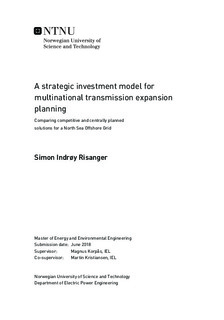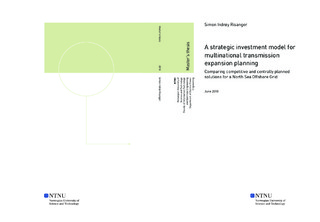| dc.description.abstract | Proper transmission expansion planning (TEP) is important to create an efficient electricity market that provide both economic and environmental benefits. However, if the expansion planner do not consider how the market agents act, situations may arise where market power can be exploited. To prevent this outcome, we propose a trilevel TEP problem where a market operator is in the lower level, multiple strategic countries trying to maximise their own welfare are in the intermediate and a benevolent system planner is in the upper level. Their actions will anticipate the behaviour of the other market participants.
When transforming the trilevel problem to a mixed-integer liner program (MILP), we use Karush Kuhn Tucker (KKT) conditions as optimality conditions for the lower level problem. The non-convex complementarity constraints are linearised into disjunctive constraints. To generate the intermediate problem optimality conditions, we again use KKT conditions, but exploit the relationship between the binary variables of the disjunctive constraints and the dual variables. We extend on current methodology which has to scan through multiple equilibria to find or guarantee the best solution, by providing a method of solving the trilevel TEP problem as a MILP directly to a global optimum.
The method is demonstrated on a case study consisting of Germany, Great Britain and Norway. Strategic countries are only trying to maximise their consumer surplus, because the non-convex bilinear expressions of producer surplus and congestion rents prevents necessity and sufficiency of KKT conditions. The minimisation of domestic prices is therefore the main objective of the strategic countries. Compared to a centrally planned expansion, which can be accomplished if the countries cooperate towards a supra-national regulator, the strategic framework deploy their generation assets less efficiently. The countries are focused on their individual goals and over-invest in domestic production. Consequently, there is less need for transmission expansion because the countries become more self-sufficient. As a result, the countries cannot diversify the risk of intermittent renewable production among each other, and are still dependent on more expensive fossil fuel generation. For the case study, a significant increase of five times the original generation investment cost was necessary for the countries to become sufficiently reluctant to invest for the transmission planner to deem it appropriate to invest in corridors. The centrally planned framework, on the other hand, invests in a lot of transmission capacity and little generation. She is able to use the system assets more efficiently and make a larger transition into renewable generation. Our case study show potential of decreasing total cost if a system moves from a strategic framework towards central planning. However, if strategic countries also try to maximise producer surplus and congestion rent they would gain an incentive to perform trade, which they lack when only consumer surplus is included. | |

